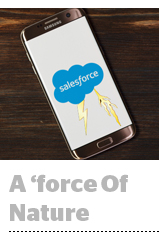 Salesforce has big plans for its recently released customer data platform (CDP), Customer 360.
Salesforce has big plans for its recently released customer data platform (CDP), Customer 360.
The world’s largest CRM and DMP provider is reimagining what enterprise customers need in their mar tech toolkit, Salesforce Marketing Cloud CEO Bob Stutz told AdExchanger at the company’s Connections conference in Chicago this week.
Salesforce considers its CDP product to be an evolution of CRM and not exclusively a marketing solution, Stutz said.
“It’s the ability to bring that CRM data together with an online, living profile,” he said.
Take Spalding, the sporting goods company, which has been integrating its own customer data into something like an internal CDP, but is eager to start using Customer 360, specifically as a way to help bridge marketing with other parts of the business, such as sales and customer service, said Matt Day, the brand’s digital marketing and ecommerce manager.
“There’s a need for a solution that sits across the portfolio of tech we use and all the teams internally that can get value from the data,” Day said.
Customer service teams, for example, need a sense of personalization almost like you get with online advertising to know who people are when they call in for support. A loyalty program member needs a different experience than a sports coach, a retail distributor or a key brand partner, like an NCAA team that uses Spalding basketballs.
Although Customer 360 will eventually become the connective tissue for brands using multiple Salesforce clouds or products, Stutz said, the initial use cases will center on marketing.
Having a central customer identity set to use with Salesforce will help the marketing team “go from recommending things to customers to anticipating needs,” said e.l.f. Cosmetics CMO Kory Marchisotto.
Customers who buy particular types of products, such as for oily or dry skin, or who have different buying patterns – some people are loyal to specific products, for example, while others prefer to constantly test new ones – expect the brand to learn from their shopping history and cater to them specifically, Marchisotto said.
For that reason, Salesforce identity data is the core of its new CDP product, Stutz said. It’s also why Salesforce’s newly launched CDP inherited its name, Customer 360, from the company’s identity graph solution.
Putting aside Adobe’s and Oracle’s respective CDP ventures, most other CDPs are startup point solutions that need to send customer data to external onboarding and identity tech services in order to turn the data into audience segments and IDs for online targeting, Stutz said.
Salesforce sees a chance to collapse that process into a single package, thus avoiding the data loss that can occur when a brand passes data through other third-party providers.
Integrating its internal product suites is also an important way for Salesforce to keep startup point solutions from growing into significant market share threats.
Now that e.l.f. Cosmetics works more holistically with Salesforce – e.l.f. now uses Salesforce’s service, marketing and commerce clouds – Marchisotto said the brand has been able consolidate its mar tech vendor roster. Although e.l.f. still uses outside customer analytics tech, such as Dynamic Yield and Custora, the increasing interconnectedness of the Salesforce clouds allows the brand to eliminate the friction of working with other third-party services, she said.
For its part, Salesforce is open to integrating with more partners, Stutz said, including other major cloud providers, namely Adobe and Oracle. “In enterprise tech you have to coexist with everybody because it’s a homogeneous environment, whether you like it or not,” he said.
But Salesforce is also only getting started in its consolidation efforts, which could have major ramifications for the crowded market of smaller players and point solutions.
The eventual end state for Salesforce is a single, holistic Salesforce Cloud, Stutz said, as many different kinds of customer data technologies, such as CRMs, DMPs, tag managers and mobile marketing companies converge to create profile-based identity solutions.
“That’s what Customer 360 is at the end of the day,” he said. “It becomes the Salesforce Cloud.”
This post was syndicated from Ad Exchanger.


More Stories
2024 Top Women in Media & Ad Tech Honorees and Special Recognition Awards Announced
StopPress exclusive Q&A – oOh! Creativity for Impact
Here’s My Beef With Ad Agencies